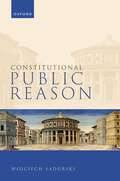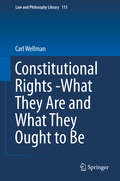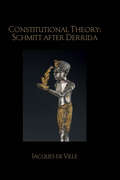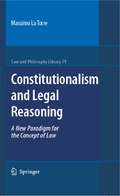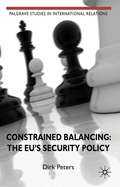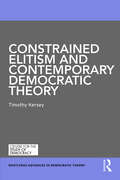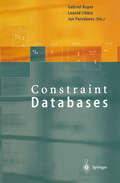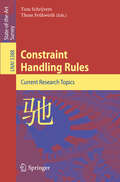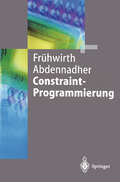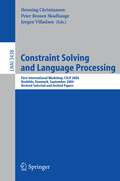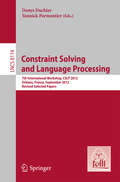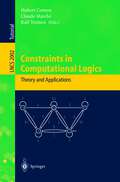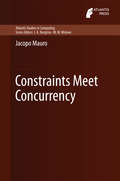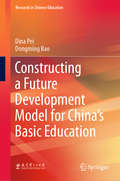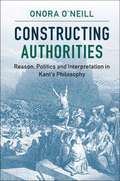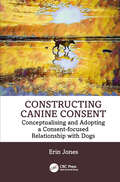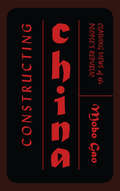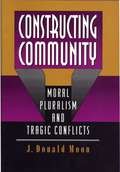- Table View
- List View
Constitutional Public Reason
by Wojciech SadurskiPublic reason, which urges that only laws based on principles reasonably agreeable to all those bound by them are legitimate, has rarely been applied to constitutional law, and never in a comparative way. This book aspires to fill that gap, by studying the use of public reason in different constitutional systems. In doing so, it studies public reason both as a normative idea - as a principle postulated for democratic constitutionalism, and as a descriptive account - as helping to understand many important doctrines in constitutional adjudication of some leading constitutional courts around the world, and also in the supranational sphere. Constitutional Public Reason questions the performance of leading 'exemplars of public reasons', including the top courts of the United States, India, Canada, Australia, Germany, and South Africa, as well as the European Court of Human Rights. It also attempts to show how this performance can be improved in fields such as freedom of expression, non-establishment of religion, and anti-discrimination law. Ultimately, it finds that the best resonance between the ideal of public reason and constitutional interpretation is found in doctrines that locate the illegitimacy of laws in the wrongful motives (or purposes) pursued by legislators. Scrutinising motives is often as important as scrutinising consequences.
Constitutional Public Reason
by Wojciech SadurskiPublic reason, which urges that only laws based on principles reasonably agreeable to all those bound by them are legitimate, has rarely been applied to constitutional law, and never in a comparative way. This book aspires to fill that gap, by studying the use of public reason in different constitutional systems. In doing so, it studies public reason both as a normative idea - as a principle postulated for democratic constitutionalism, and as a descriptive account - as helping to understand many important doctrines in constitutional adjudication of some leading constitutional courts around the world, and also in the supranational sphere. Constitutional Public Reason questions the performance of leading 'exemplars of public reasons', including the top courts of the United States, India, Canada, Australia, Germany, and South Africa, as well as the European Court of Human Rights. It also attempts to show how this performance can be improved in fields such as freedom of expression, non-establishment of religion, and anti-discrimination law. Ultimately, it finds that the best resonance between the ideal of public reason and constitutional interpretation is found in doctrines that locate the illegitimacy of laws in the wrongful motives (or purposes) pursued by legislators. Scrutinising motives is often as important as scrutinising consequences.
Constitutional Rights -What They Are and What They Ought to Be (Law and Philosophy Library #115)
by Carl WellmanThis work explains the nature of constitutional rights. It does so by means of an analysis of the nature of law in general, the nature of constitutions, and the nature of rights. It looks in detail at several aspects of constitutional law, rights and institutions, as well as aspects related to public officials, private persons and associations. In addition, the book critically examines a considerable number of debates about whether some actual or proposed constitutional rights ought to be established and maintained in the United States constitution. It then identifies the kinds of reasons that justify or fail to justify constitutional rights. The book advances the debate and makes a contribution to the theory and the practice of constitutional rights.
Constitutional Theory: Schmitt After Derrida (Birkbeck Law Press)
by Jacques de VilleThis book advances a new reading of the central works of Carl Schmitt and, in so doing, rethinks the primary concepts of constitutional theory. In this book, Jacques de Ville engages in a close analysis of a number of Schmitt’s texts, including Dictatorship (1921), The Concept of the Political (1927), Constitutional Theory (1928), Land and Sea (1942), Ex Captivitate Salus (1950), The Nomos of the Earth (1950) and The Theory of the Partisan (1963). This engagement takes place from the perspective of constitutional theory and focuses specifically on concepts or themes such as sovereignty, the state, the political, constituent power, democracy, representation, the constitution and human rights. The book seeks to rethink the structure of these concepts in line with Derrida’s analysis of Schmitt’s texts on the concept of the political in Politics of Friendship (1993). This happens by way of an analysis of Derrida’s engagement with Freud and other psychoanalysts. Although the main focus in the book is on Schmitt’s texts, it further examines two texts of Derrida (Khōra (1993) and Fors: The Anglish Words of Nicholas Abraham and Maria Torok (1976)), by reading these alongside Schmitt’s own reflections on the positive concept of the constitution.
Constitutional Theory: Schmitt After Derrida (Birkbeck Law Press)
by Jacques de VilleThis book advances a new reading of the central works of Carl Schmitt and, in so doing, rethinks the primary concepts of constitutional theory. In this book, Jacques de Ville engages in a close analysis of a number of Schmitt’s texts, including Dictatorship (1921), The Concept of the Political (1927), Constitutional Theory (1928), Land and Sea (1942), Ex Captivitate Salus (1950), The Nomos of the Earth (1950) and The Theory of the Partisan (1963). This engagement takes place from the perspective of constitutional theory and focuses specifically on concepts or themes such as sovereignty, the state, the political, constituent power, democracy, representation, the constitution and human rights. The book seeks to rethink the structure of these concepts in line with Derrida’s analysis of Schmitt’s texts on the concept of the political in Politics of Friendship (1993). This happens by way of an analysis of Derrida’s engagement with Freud and other psychoanalysts. Although the main focus in the book is on Schmitt’s texts, it further examines two texts of Derrida (Khōra (1993) and Fors: The Anglish Words of Nicholas Abraham and Maria Torok (1976)), by reading these alongside Schmitt’s own reflections on the positive concept of the constitution.
Constitutionalism and Legal Reasoning (Law and Philosophy Library #79)
by Massimo La TorreThis book of legal philosophy contends that positive law is better understood if it is not too easily equated with power, force, or command. Law is more a matter of discourse and deliberation than of sheer decision or of power relations. Here is thought-provoking reading for lawyers, advocates, scholars of jurisprudence, students of law, philosophy and political science, and general readers concerned with the future of the constitutional state.
Constitutive Justice
by William A. BarbieriBoth classical and modern accounts of justice largely overlook the question of how the communities within which justice applies are constituted in the first place. This book addresses that problem, arguing that we need to accord a place to the theory of 'constitutive justice' alongside traditional categories of distributive and commutative justice.
Constrained Balancing: The Eu's Security Policy (Palgrave Studies in International Relations)
by D. PetersThe creation of the EU's autonomous security policy in 1999 ended ten years of political conflict. In this book, the policies of Britain and Germany are analyzed as those of 'constrained balancing': balancing US post-Cold War supremacy with the constraints of established security institutions.
Constrained Elitism and Contemporary Democratic Theory (Routledge Advances in Democratic Theory)
by Timothy KerseyToday, examples of the public’s engagement with political issues through commercial and communicative mechanisms have become increasingly common. In February 2012, the Susan G. Komen Foundation reversed a decision to cease funding of cancer screening programs through Planned Parenthood amidst massive public disapproval. The same year, restaurant chain Chic-fil-A became embroiled in a massive public debate over statements its President made regarding same-sex marriage. What exactly is going on in such public engagement, and how does this relate to existing ideas regarding the public sphere and political participation? Is the public becoming increasingly vocal in its complaints? Or are new relationships between the public and economic and political leaders emerging? Timothy Kersey’s book asserts that the widespread utilization of internet communications technologies, especially social media applications, has brought forth a variety of new communicative behaviors and relationships within liberal polities. Through quick and seemingly chaotic streams of networked communication, the actions of these elites are subject to increasingly intense scrutiny and short-term pressure to ameliorate or at least address the concerns of segments of the population. By examining these new patterns of behavior among both elites and the general public, Kersey unearths the implications of these patterns for contemporary democratic theory, and argues that contemporary conceptualizations of "the public’" need to be modified to more accurately reflect practices of online communication and participation. By engaging with this topical issue, Kersey is able to closely examine the self-organization of both elite and non-elite segments of the population within the realm of networked communication, and the relations and interactions between these segments. His book combines perspectives from political theory and communication studies and so will be widely relevant across both disciplines.
Constrained Elitism and Contemporary Democratic Theory (Routledge Advances in Democratic Theory)
by Timothy KerseyToday, examples of the public’s engagement with political issues through commercial and communicative mechanisms have become increasingly common. In February 2012, the Susan G. Komen Foundation reversed a decision to cease funding of cancer screening programs through Planned Parenthood amidst massive public disapproval. The same year, restaurant chain Chic-fil-A became embroiled in a massive public debate over statements its President made regarding same-sex marriage. What exactly is going on in such public engagement, and how does this relate to existing ideas regarding the public sphere and political participation? Is the public becoming increasingly vocal in its complaints? Or are new relationships between the public and economic and political leaders emerging? Timothy Kersey’s book asserts that the widespread utilization of internet communications technologies, especially social media applications, has brought forth a variety of new communicative behaviors and relationships within liberal polities. Through quick and seemingly chaotic streams of networked communication, the actions of these elites are subject to increasingly intense scrutiny and short-term pressure to ameliorate or at least address the concerns of segments of the population. By examining these new patterns of behavior among both elites and the general public, Kersey unearths the implications of these patterns for contemporary democratic theory, and argues that contemporary conceptualizations of "the public’" need to be modified to more accurately reflect practices of online communication and participation. By engaging with this topical issue, Kersey is able to closely examine the self-organization of both elite and non-elite segments of the population within the realm of networked communication, and the relations and interactions between these segments. His book combines perspectives from political theory and communication studies and so will be widely relevant across both disciplines.
Constraint Databases
by Gabriel Kuper Leonid Libkin Jan ParedaensThis is the first comprehensive survey of the field of constraint databases, written by leading researchers. Constraint databases are a fairly new and active area of database research. Their ability to deal with infinite sets makes them particularly promising as a technology for integrating spatial and temporal data with standard relational databases. Constraint databases bring techniques from a variety of fields, such as logic and model theory, algebraic and computational geometry, as well as symbolic computation, to the design and analysis of data models and query languages.
Constraint Handling Rules: Current Research Topics (Lecture Notes in Computer Science #5388)
by Tom Schrijvers Thom ÜhwirthThe ConstraintHandling Rules (CHR) languagecameto life morethan 15 years ago.Sincethen,ithasbecomeamajordeclarativespeci?cationandimplemen- tion language for constraint-based algorithms and applications. In recent years, the ?ve Workshops on Constraint Handling Rules have spurred the exchange of ideas within the CHR community, which has led to increased international collaboration, new theoretical results and optimized implementations. The aim of this volume of Lecture Notes in Ariti?cial Intelligence was to attract high-quality research papers on these recent advances in CHR. The 8 papersinthis issuewereselectedfrom11submissionsaftercarefulreviewingand subsequent revisions. Each paper was reviewd by three reviewers. The accepted papers represent some of the research teams on CHR around the world. It is not by accident that the currently most active research group is featured here with three articles. We also would have liked to see contributions from other CHR teams, but space is limited and the reviewers took their job seriously. After an introductory article that foreshadows an upcoming monograph on CHR, the accepted papers span a range of current research topics in the CHR community. It goes from extending the CHR language with search facilities and the related adaptive framework, and from generating rules from speci?cations of constraint solvers to implementing abductive probabilistic reasoning. They cover the theory that is a compositional semantics for CHR and ?nally describe e?cient implementations of CHR in traditional mainstream programming l- guages and compiler optimizations in the context of the re?ned semantics of CHR. Wewouldliketothanktheauthorsofsubmittedpapersandthemanyrevi- ers for their contribution in making this collection of research papers possible.
Constraint-Programmierung: Grundlagen und Anwendungen (Springer-Lehrbuch)
by Thom Frühwirth Slim AbdennadherDas Buch gibt einen kompakten, aber umfassenden Überblick über das Problemlösen und Programmieren mit "Constraints" (Randbedingungen). Diese aktuelle Programmiermethodik ermöglicht es, Aufgaben direkt zu formulieren und effizient zu lösen. Sie gewinnt zusehends Bedeutung in Anwendungsbereichen wie Kombinatorische Suchprobleme (z.B. Zeitplanen, Layout-Optimierung), Berechnungen (Finanzanalyse), Simulation (Hardware-Verifikation) oder allgemein Schließen und Rechnen mit ungenauer oder unvollständiger Information (z.B. Kostenschätzung). Die theoretisch fundierte Darstellung mit Aufgaben und Anwendungsbeispielen aus der Praxis ist in der Lehre erprobt, aber auch für Forscher und Praktiker von Nutzen.
Constraint Solving and Language Processing: First International Workshop, CSLP 2004, Roskilde, Denmark, September 1-3, 2004, Revised Selected and Invited Papers (Lecture Notes in Computer Science #3438)
by Henning Christiansen Peter Rossen Skadhauge Jørgen VilladsenThis volume contains selected and thoroughly revised papers plus contributions from invited speakers presented at the First International Workshop on C- straint Solving and Language Processing, held in Roskilde, Denmark, September 1–3, 2004. Constraint Programming and Constraint Solving, in particular Constraint Logic Programming, appear to be a very promising platform, perhaps the most promising present platform, for bringing forward the state of the art in natural language processing, this due to the naturalness in speci?cation and the direct relation to e?cient implementation. Language, in the present context, may - fer to written and spoken language, formal and semiformal language, and even general input data to multimodal and pervasive systems, which can be handled in very much the same ways using constraint programming. The notion of constraints, with slightly di?ering meanings, apply in the ch- acterization of linguistic and cognitive phenomena, in formalized linguistic m- els as well as in implementation-oriented frameworks. Programming techniques for constraint solving have been, and still are, in a period with rapid devel- ment of new e?cient methods and paradigms from which language processing can pro?t. A common metaphor for human language processing is one big c- straintsolvingprocessinwhichthedi?erent(-lyspeci?ed)linguisticandcognitive phases take place in parallel and with mutual cooperation, which ?ts quite well with current constraint programming paradigms.
Constraint Solving and Language Processing: 7th International Workshop, CSLP 2012, Orléans, France, September 13-14, 2012, Revised Selected Papers (Lecture Notes in Computer Science #8114)
by Denys Duchier Yannick ParmentierThe Constraint Solving and Language Processing (CSLP) workshop considers the role of constraints in the representation of language and the implementation of language processing applications. This theme should be interpreted inclusively: it includes contributions from linguistics, computer science, psycholinguistics and related areas, with a particular interest in interdisciplinary perspectives. Constraints are widely used in linguistics, computer science, and psychology. How they are used, however, varies widely according to the research domain: knowledge representation, cognitive modelling, problem solving mechanisms, etc. These different perspectives are complementary, each one adding a piece to the puzzle.
Constraints in Computational Logics: International Summer School, CCL'99 Gif-sur-Yvette, France, September 5-8, 1999 Revised Lectures (Lecture Notes in Computer Science #2002)
by Hubert Comon Claude Marche Ralf TreinenConstraints provide a declarative way of representing infinite sets of data. They are well suited for combining different logical or programming paradigms as has been known for constraint logic programming since the 1980s and more recently for functional programming. The use of constraints in automated deduction is more recent and has proved to be very successful, moving the control from the meta-level to the constraints, which are now first-class objects.This monograph-like book presents six thoroughly reviewed and revised lectures given by leading researchers at the summer school organized by the ESPRIT CCL Working Group in Gif-sur-Yvette, France, in September 1999. The book offers coherently written chapters on constraints and constraint solving, constraint solving on terms, combining constraint solving, constraints and theorem proving, functional and constraint logic programming, and building industrial applications.
Constraints, Language and Computation (Cognitive Science)
by M. A. Rosner C. J. Rupp Torrence JohnsonConstraint-based linguistics is intersected by three fields: logic, linguistics, and computer sciences. The central theme that ties these different disciplines together is the notion of a linguistic formalism or metalanguage. This metalanguage has good mathematical properties, is designed to express descriptions of language, and has a semantics that can be implemented on a computer. Constraints, Language and Computation discusses the theory and practice of constraint-based computational linguistics. The book captures both the maturity of the field and some of its more interesting future prospects during a particulary important moment of development in this field.
Constraints Meet Concurrency (Atlantis Studies in Computing #5)
by Jacopo MauroThis book describes the benefits that emerge when the fields of constraint programming and concurrency meet. On the one hand, constraints can be used in concurrency theory to increase the conciseness and the expressive power of concurrent languages from a pragmatic point of view. On the other hand, problems modeled by using constraints can be solved faster and more efficiently using a concurrent system. Both directions are explored providing two separate lines of development. Firstly the expressive power of a concurrent language is studied, namely Constraint Handling Rules, that supports constraints as a primitive construct. The features of this language which make it Turing powerful are shown. Then a framework is proposed to solve constraint problems that is intended to be deployed on a concurrent system. For the development of this framework the concurrent language Jolie following the Service Oriented paradigm is used. Based on this experience, an extension to Service Oriented Languages is also proposed in order to overcome some of their limitations and to improve the development of concurrent applications.
Constructing a Future Development Model for China’s Basic Education (Research in Chinese Education)
by Dina Pei Dongming BaoFocusing on the future development of basic education in China, and on overcoming related issues, this book identifies key breakthroughs, priorities and important fields of basic education reform. In addition, it introduces the “Three Power Model” – decision-making, principals’ leadership, and learning power – to help address the challenges of future development.Unlike much of the research on basic education reform, the book draws on a forward-thinking, realistic and comprehensive project: bringing together 15 universities and research institutes, 16 provincial administration departments, and 100 selected primary and secondary schools, it has also been strongly endorsed by the nation’s leaders. After five years of practice and innovation, it has made significant breakthroughs in many provinces. Sharing unique insights into the project and its outcomes, the book offers an invaluable asset for education researchers, primary and secondary school teachers, and anyone interested in the evolution of basic education in China.
Constructing Authorities, Reason, Politics and Interpretation in Kant's Philosophy (PDF)
by Onora O'NeillThis collection of essays brings together the central lines of thought in Onora O’Neill’s work on Kant’s philosophy, developed over many years. Challenging the claim that Kant’s attempt to provide a critique of reason fails because it collapses into a dogmatic argument from authority, O’Neill shows why Kant held that we must construct, rather than assume, the authority of reason, and how this can be done by ensuring that anything we offer as reasons can be followed by others, including others with whom we disagree. She argues that this constructivist view of reasoning is the clue to Kant’s claims about knowledge, ethics and politics, as well as to his distinctive accounts of autonomy, the social contract, cosmopolitan justice and scriptural interpretation. Her essays are a distinctive and illuminating commentary on Kant’s fundamental philosophical strategy and its implications, and will be a vital resource for scholars of Kant, ethics and philosophy of law.
Constructing Canine Consent: Conceptualising and adopting a consent-focused relationship with dogs
by Erin JonesThe concept of canine consent is far more than simply a buzzword in modern dog training practices. In its current form, consent is a distinctly human concept, designed by humans and for humans. Looking beyond species boundaries can help us not only consider concepts of canine consent and autonomy, but it can also help us to apply these concepts in our everyday interactions with dogs, which is fundamental for any professional working with dogs as well as for everyday dog caregivers. This canine-indexed definition of consent includes a model of five major categories: Touch/interaction-based consent, cooperative care using learned consent behaviours, activity consent, consent-based learning, and substitutive consent. These categories involve a two-way communication system, integration of salient choices, teaching consent behaviours and incorporating existing training protocols that adhere to the Humane Hierarchy of best practices, and an evaluation of dependent decision-making in extenuating circumstances. This book aims to merge the existing literature and new understandings about canine consent to paint a complete picture. It will challenge the current expectations of dogs and dog behaviour in our society with an intention of considering their perspectives, experiences, and emotional needs. It will be important reading for veterinary professionals, dog trainers and behaviourists, those involved in work with therapy dogs, and anybody working with or caring for dogs.
Constructing Canine Consent: Conceptualising and adopting a consent-focused relationship with dogs
by Erin JonesThe concept of canine consent is far more than simply a buzzword in modern dog training practices. In its current form, consent is a distinctly human concept, designed by humans and for humans. Looking beyond species boundaries can help us not only consider concepts of canine consent and autonomy, but it can also help us to apply these concepts in our everyday interactions with dogs, which is fundamental for any professional working with dogs as well as for everyday dog caregivers. This canine-indexed definition of consent includes a model of five major categories: Touch/interaction-based consent, cooperative care using learned consent behaviours, activity consent, consent-based learning, and substitutive consent. These categories involve a two-way communication system, integration of salient choices, teaching consent behaviours and incorporating existing training protocols that adhere to the Humane Hierarchy of best practices, and an evaluation of dependent decision-making in extenuating circumstances. This book aims to merge the existing literature and new understandings about canine consent to paint a complete picture. It will challenge the current expectations of dogs and dog behaviour in our society with an intention of considering their perspectives, experiences, and emotional needs. It will be important reading for veterinary professionals, dog trainers and behaviourists, those involved in work with therapy dogs, and anybody working with or caring for dogs.
Constructing China: Clashing Views of the Peoples Republic
by Mobo GaoFrom fear and anxiety, to celebration, China's rise has provoked a variety of responses across the world. In light of this phenomenon, how are our understandings of China produced?*BR**BR*From West to East, Mobo Gao interrogates knowledge production; rejecting the supposed objectivity of empirical statistics and challenging the assumption of a dichotomy between the Western liberal democracy and Chinese authoritarianism. By examining issues such as the Chinese Neo-Enlightenment and neoliberalism, national interest vested in Western scholarship, representations of the Great Leap Forward and the Cultural Revolution, and the South China Sea, the book asks: how is contemporary China constructed?*BR**BR*By dissecting the political agenda and conceptual framework of commentators on China, Gao provocatively urges those not only on the Right, but also on the Left, to be self-critical of their views on Chinese politics, economics and history.
Constructing China: Clashing Views of the Peoples Republic
by Mobo GaoFrom fear and anxiety, to celebration, China's rise has provoked a variety of responses across the world. In light of this phenomenon, how are our understandings of China produced?*BR**BR*From West to East, Mobo Gao interrogates knowledge production; rejecting the supposed objectivity of empirical statistics and challenging the assumption of a dichotomy between the Western liberal democracy and Chinese authoritarianism. By examining issues such as the Chinese Neo-Enlightenment and neoliberalism, national interest vested in Western scholarship, representations of the Great Leap Forward and the Cultural Revolution, and the South China Sea, the book asks: how is contemporary China constructed?*BR**BR*By dissecting the political agenda and conceptual framework of commentators on China, Gao provocatively urges those not only on the Right, but also on the Left, to be self-critical of their views on Chinese politics, economics and history.
Constructing Community: Moral Pluralism and Tragic Conflicts (PDF)
by J. Donald MoonIn developing a new theory of political and moral community, J. Donald Moon takes questions of cultural pluralism and difference more seriously than do many other liberal thinkers of our era: Moon is willing to confront the problem of how community can be created among those who have very different views about the proper ends of human life. Experiencing such profound disagreement, can we live together in a society under norms we all accept? In recent years, traditional ways of looking at this query have come under attack by post-modernists, feminists, and thinkers concerned with pluralism. Respectfully engaging their critiques, Moon proposes a reformulated liberalism that is intended to overcome the problems they have identified.
